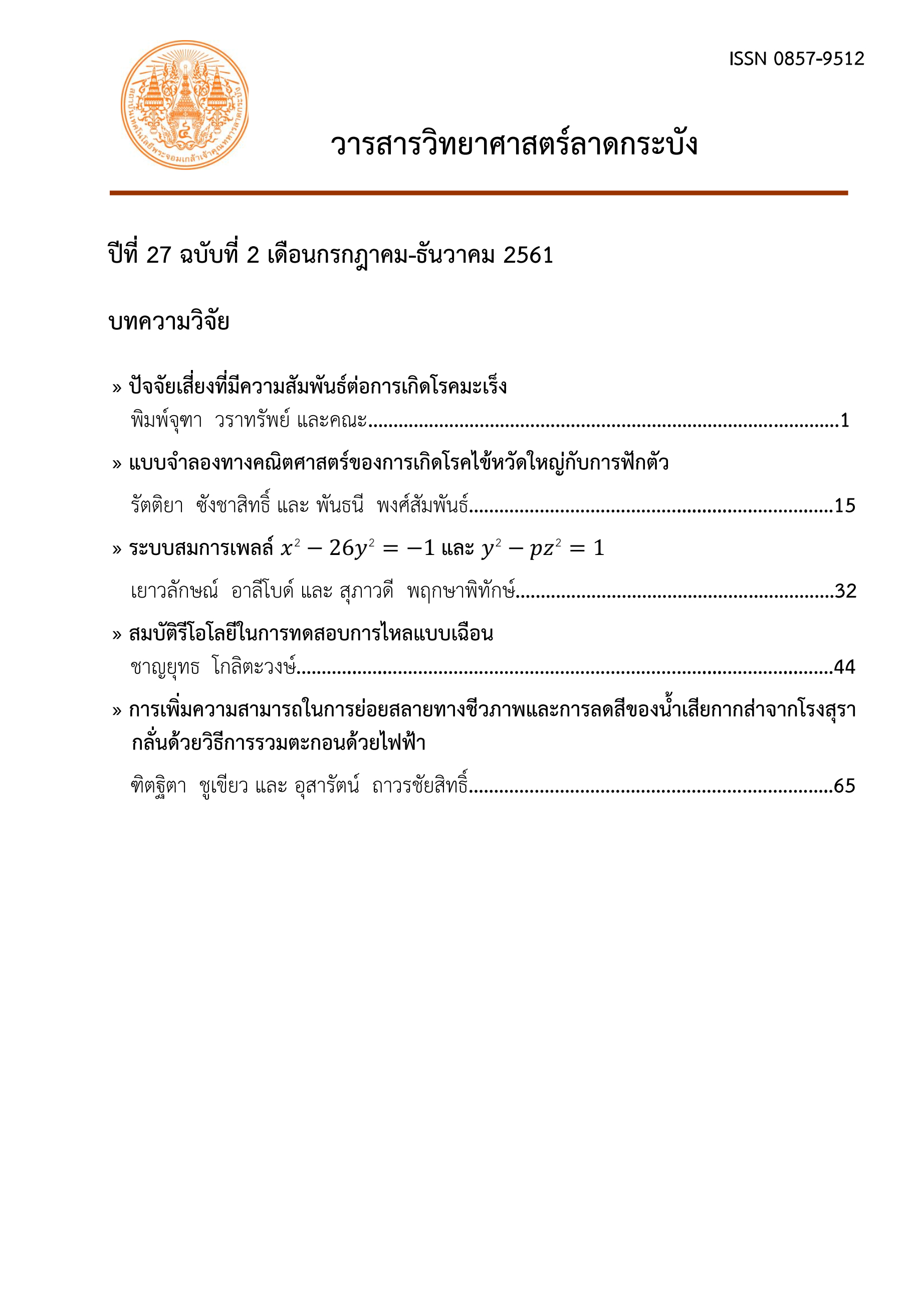แบบจำลองทางคณิตศาสตร์ของการเกิดโรคไข้หวัดใหญ่กับการฟักตัว
Main Article Content
Abstract
Influenza virus is found in the nasal saliva and sputum of patients. (This type of virus is classified as a virus called Orthomyxovirus.)This disease is a viral infection in the acute respiratory tract.Influenza virus has 2 types such as influenza virus and influenza virus B. In this research, Researchers conducted a mathematical model to explain the influenza epidemic by considering different incubations. The equilibrium points, condition for stabilities of the disease free and endemic states are investigated.The basic reproductive numbers are shown. A numerical analysis shows the results of simulations. The analysis found that value of and change will affect the outbreak.
Keywords: Incubation, Influenza, basic reproductive numbers, stability, steadystate, mathematical model
บทคัดย่อ
เชื้อไข้หวัดใหญ่เป็นเชื้อไวรัสที่มีชื่อว่า ไวรัสอินฟลูเอนซา (Influenza Virus) ซึ่งมีอยู่ในน้ำมูก น้ำลาย และเสมหะของผู้ป่วย โรคชนิดนี้เป็นการติดเชื้อไวรัสที่ระบบทางเดินหายใจแบบเฉียบพลัน โดยที่เชื้อไวรัสอินฟลูเอนซามีทั้งหมด 2 สายพันธุ์ใหญ่ ได้แก่ไข้หวัดใหญ่สายพันธุ์ A และไข้หวัดใหญ่สายพันธุ์ B ในงานวิจัยนี้ผู้วิจัยได้ทำการศึกษาแบบจำลองทางคณิตศาสตร์เพื่ออธิบายการแพร่ระบาดของโรคไข้หวัดใหญ่โดยพิจารณาการฟักตัวของโรคที่แตกต่างกัน ผู้วิจัยได้ทำการหาจุดสมดุลหาเงื่อนไขที่ทำให้เกิดความเสถียรภาพของจุดสมดุลภายใต้สภาวะไร้โรคและสภาวะการระบาดอย่างเรื้อรังแล้วนำมาแสดงในรูปของค่าสืบพันธุ์พื้นฐานมีการวิเคราะห์เชิงตัวเลขเพื่อแสดงผลลัพธ์ของแบบจำลองด้วย หลังจากการวิเคราะห์พบว่าค่าของ และ จะทำให้มีการเปลี่ยนแปลงแล้วส่งผลต่อการระบาดของโรค
คำสำคัญ: การฟักตัว ไข้หวัดใหญ่ ค่าสืบพันธุ์พื้นฐาน ความเสถียรภาพจุดสมดุลแบบจำลองทางคณิตศาสตร์
Article Details
References
[2] โรคไข้หวัดใหญ่สายพันธุ์H1N1.[ออนไลน์]. เข้าถึงได้จาก:
[3] โรคไข้หวัดใหญ่สายพันธุ์H1N1. [ออนไลน์]. เข้าถึงได้จาก:
[4] สุรเกียรติ อาชานุภาพ, หนังสือตำราตรวจรักษาโรคทั่วไป 2 “ไข้หวัดใหญ่ ( Influenza /Flu)” หน้า 393 – 396.[SurakiatAunchurat, General infectious disease treatment book 2, “influenza (Influenza / Flu)”, Page 393 – 396.(in Thai)]
[5] สำนักโรคติดต่ออุบัติใหม่ กรมควบคุมโรค กระทรวงสาธารณสุข. “สถานการณ์ไข้หวัดใหญ่ H1N1 (1 มกราคม – 26 ธันวาคม 2558” [ออนไลน์]. เข้าถึงได้จาก:
[6] Esteva, L. & Vargas. C. 1998. Analysis of a dengue disease Transmission model. Mathematical Biolosciences, 150, 131-151.
[7] Leah, E.K. 1998. Mathematical Models in Biology. New York: Random House.
[8] Samuel Okyere, F. T. Oduro, Ebenezer Bonyah and LoiusMunkayazi, 2013, Epidemiological model of influenza a (H1N1) transmission in Ashanti Region of Ghana, 2012, Journal of Public Health and Epidemiology,5(4),DOI:10.5897/JPHE2013.0512, ISSN2006-9723©2013 Academic Journals,160 – 166.
[9] Radzuan Razali and SamsulAriffin Abdul Karim. 2013, Estimation of the reproduction number of the novel influenza A, H1N1 in Malaysia, IJSIT (www.ijsit.com), Volume 2, Issue 5, September-October 2013,359 -366.
[10] R.Sungchasit, P.Pongsumpun and I.M.Tang. 2015. SIR Transmission Model of Dengue Virus Taking Into Account Two Species of Mosquitoes and an Age Structure in the Human Population,American Journal of Applied Sciences, 12(6), 426 – 443.
[11] RattiyaSungchasit , PuntaniPongsumpunand I Ming Tang.2017, Environmental impact on the spread of dengue virus when two mosquito species circulate , Far East Journal of Mathematical Sciences (FJMS), Volume 101, Number 1, 137-170, ISSN: 0972-0871.
[12] Kedall.A. 1993, Elementary Numerical Analysis,2nded. John Wiley &sons,USA.

